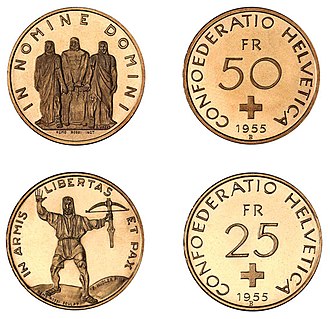25 and 50 franc coins
The 25 and 50 franc coins were two planned Swiss currency coins made of gold that were minted in the mid-1950s. For currency and market policy reasons, however, they have not yet been issued.
history
On December 17, 1952, the revised federal law on coinage came into force. This provided for in Article 3 Kurant coins of 25 and 50 francs made of gold. In 1954, 24 sculptors took part in a competition to find motifs. The conditions of the competition stipulated, among other things, the following: “The drafts should take into account the individuality of our country; the obverse should preferably have an allegorical figure of a specific Swiss character, but not a woman's head. ” A woman's head was excluded as a motif, since the two previous gold coins, Helvetia and Vreneli , already bore this motif.
None of the works could convince the jury. Therefore, the four best-placed artists were invited to take part in another competition with revised or completely new designs, which also ended with no results.
The head of the finance department, Federal Councilor Hans Streuli , then worked with representatives from art, politics and science to define more precise guidelines for the design. The front of the 25-franc piece should depict the crossbow or the ibex and the 50-franc piece the oath as symbols of freedom. The back of the coins should be designed uniformly.
In the third competition, in which ten artists took part, no worthy coin image was found despite the specified criteria.
Finally, the two artists Remo Rossi and Battista Ratti were commissioned to design the coins together. The Rütli oath by Vibert and the Tell by Hodler were set as motifs . After some details were changed, the coins were approved by the Federal Council and sample copies were presented to the public. This accepted the coins rather negatively. The inscription on the 25-franc piece IN ARMIS LIBERTAS ET PAX was objected to by the Swiss Peace Council. The Basler Nachrichten wrote: “Should 'Freedom and Peace in Arms' really be the quintessence of the Swiss state idea?” Critics also found the fact that Remo Rossi, a member of the first jury, was involved in the design of the coins .
Ultimately, however, the coins were not issued for other reasons. By issuing the coins, the already scarce gold reserves of the National Bank would have decreased further, but this contradicted their interests. In addition, between the minting and the planned issue, the gold price had risen so sharply that it exceeded the face value of the coins. This made issuance at face value impossible, and for legal reasons the coins could not be issued at a higher price at that time.
description
The front of the 25-franc piece shows the standing Tell with a crossbow after a painting by Ferdinand Hodler and the controversial inscription IN ARMIS LIBERTAS ET PAX (Latin: freedom and peace in arms ).
The front of the 50-franc piece shows Jean Georges Vibert's Confederation group and the inscription IN NOMINE DOMINI (Latin: In the name of the Lord , the beginning of the Federal Constitution ).
On the common reverse, the nominal value FR 25 or FR 50 and below the Swiss cross are shown in the middle . This is surrounded by the country code CONFOEDERATIO HELVETICA (Latin: Swiss Confederation ). At the bottom in the middle is the year of issue and the mintmark B for Bern.
The raised marginal writing reads for both values: ★★★ DOMINUS PROVIDEBIT ★★★★★★★★★★ (Latin: The Lord will provide for ).
| Face value | alloy | Weight | diameter | thickness |
|---|---|---|---|---|
| 25 Fr. | 90% Au , 10% Cu | 5.645 g | 20 mm | 1.33 mm |
| 50 Fr. | 90% Au, 10% Cu | 11.290 g | 25 mm | 1.70 mm |
In 1955, 1956 and 1959 5 million 25-franc pieces and 2 million 50-franc pieces each were minted.
Whereabouts
Nowadays, the coins form part of the Swiss gold reserves .
There have been several considerations about selling the coins. But these were all rejected again. There are currently no indications that it will be sold anytime soon.
In June 2009 swissmint announced that apart from a number of 20,000 coins per type and year, all 25 and 50 franc coins had been remelted into gold by the Swiss National Bank .
Individual evidence
- ↑ Article in SWISSMINTinfo 2/09 ( Memento from April 26, 2013 in the Internet Archive ) (PDF; 519 kB)
Web links
- Information about the 25 and 50 franc coins ( memento from January 14, 2016 in the Internet Archive ) (PDF; 337 kB)



